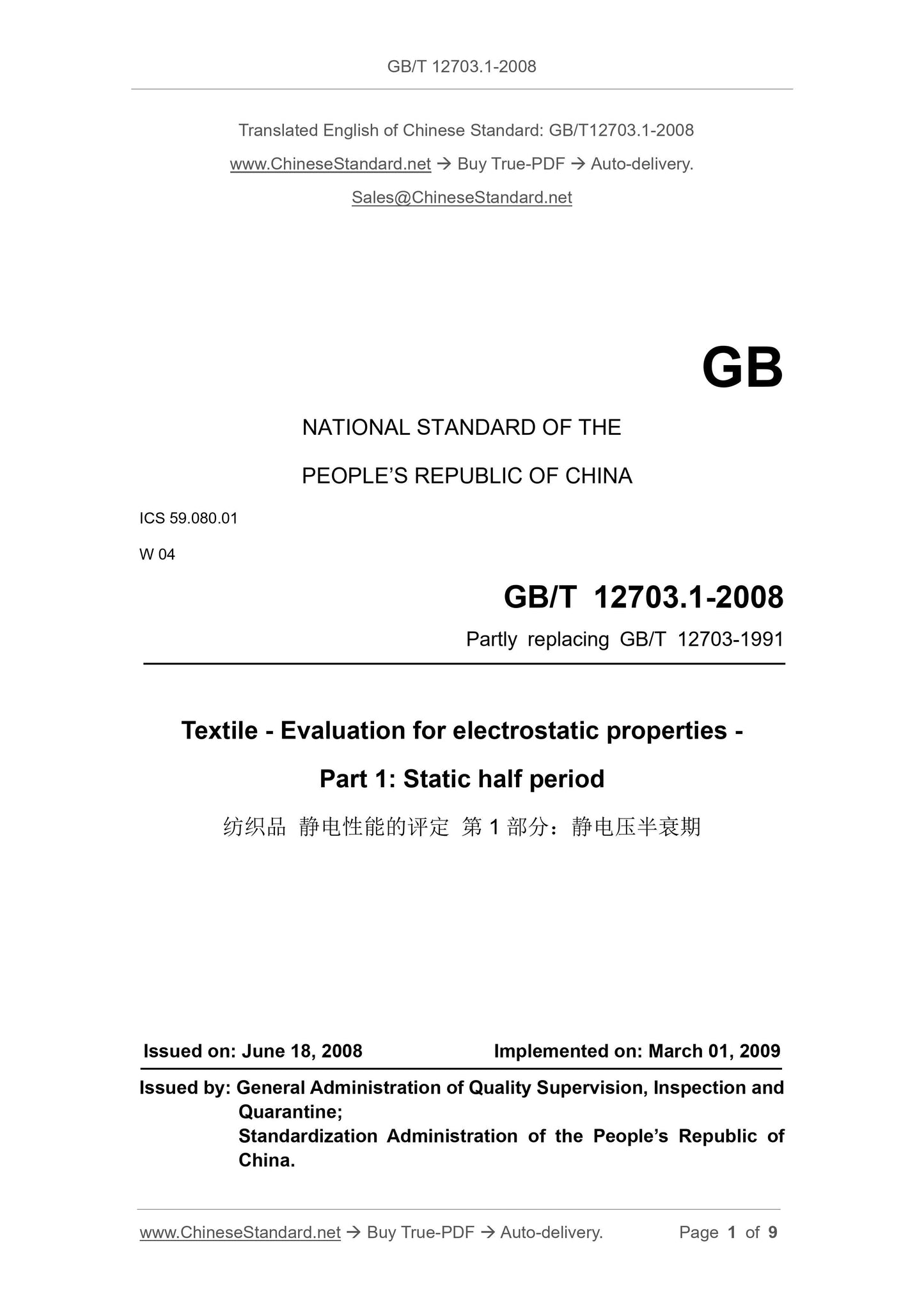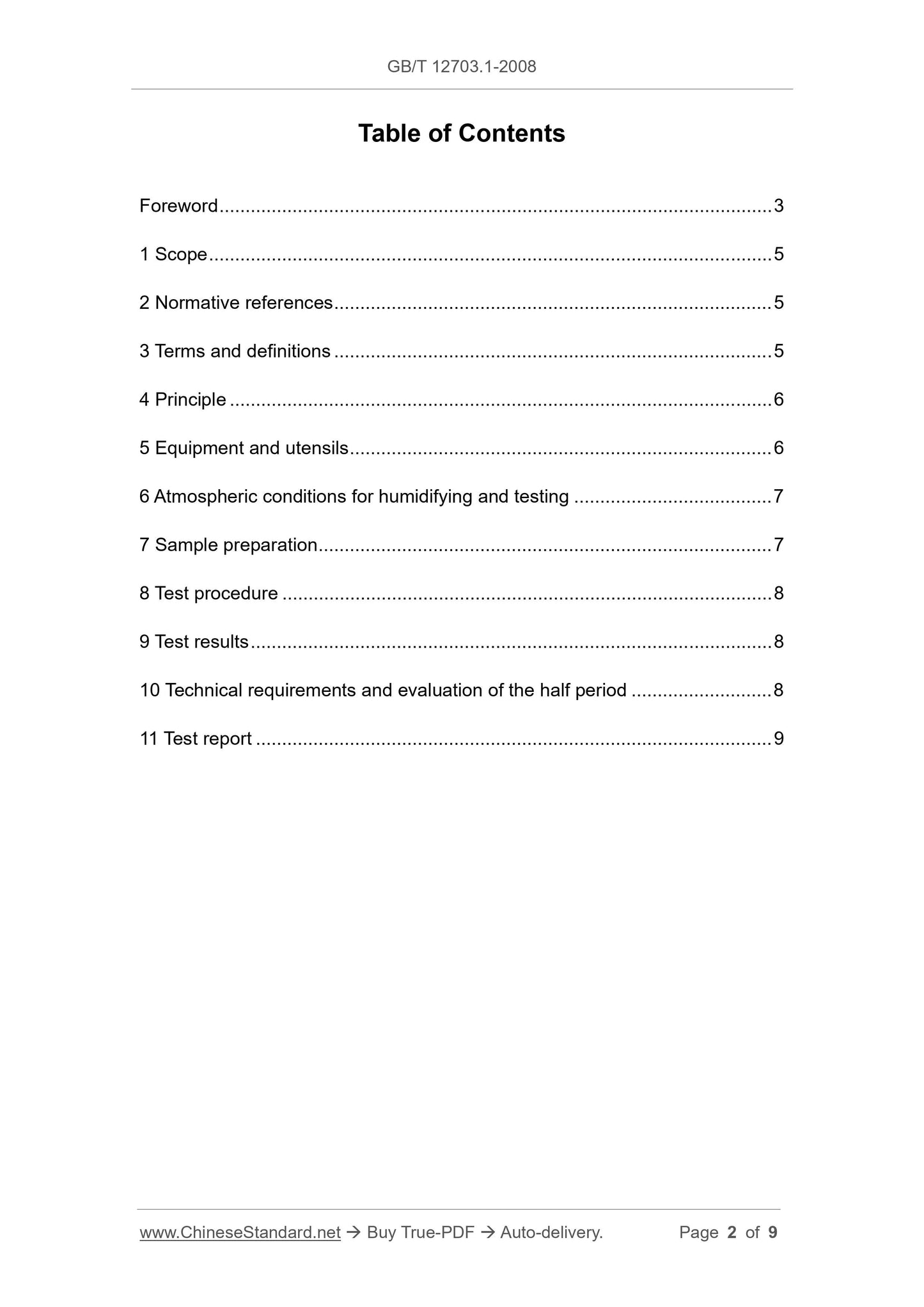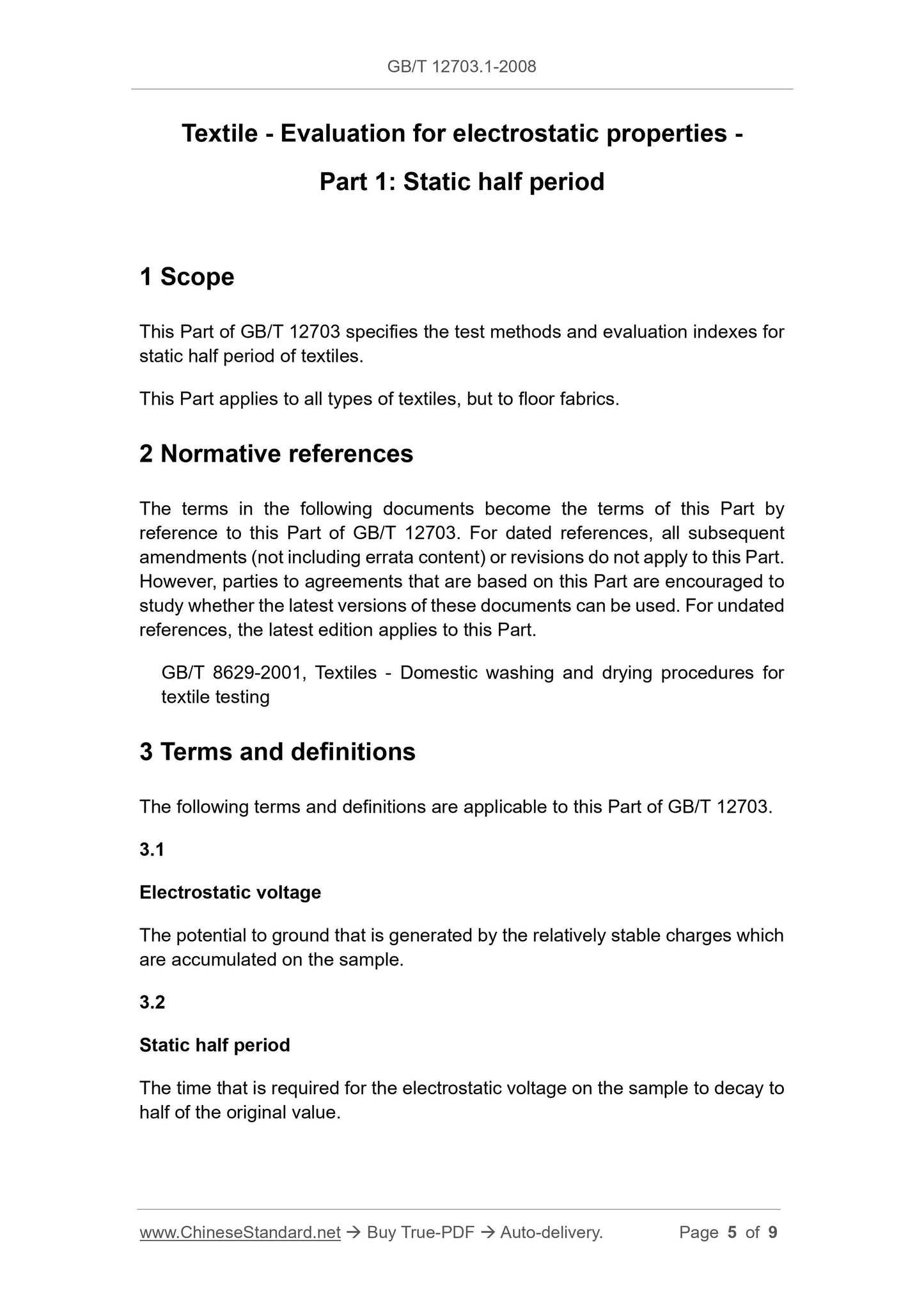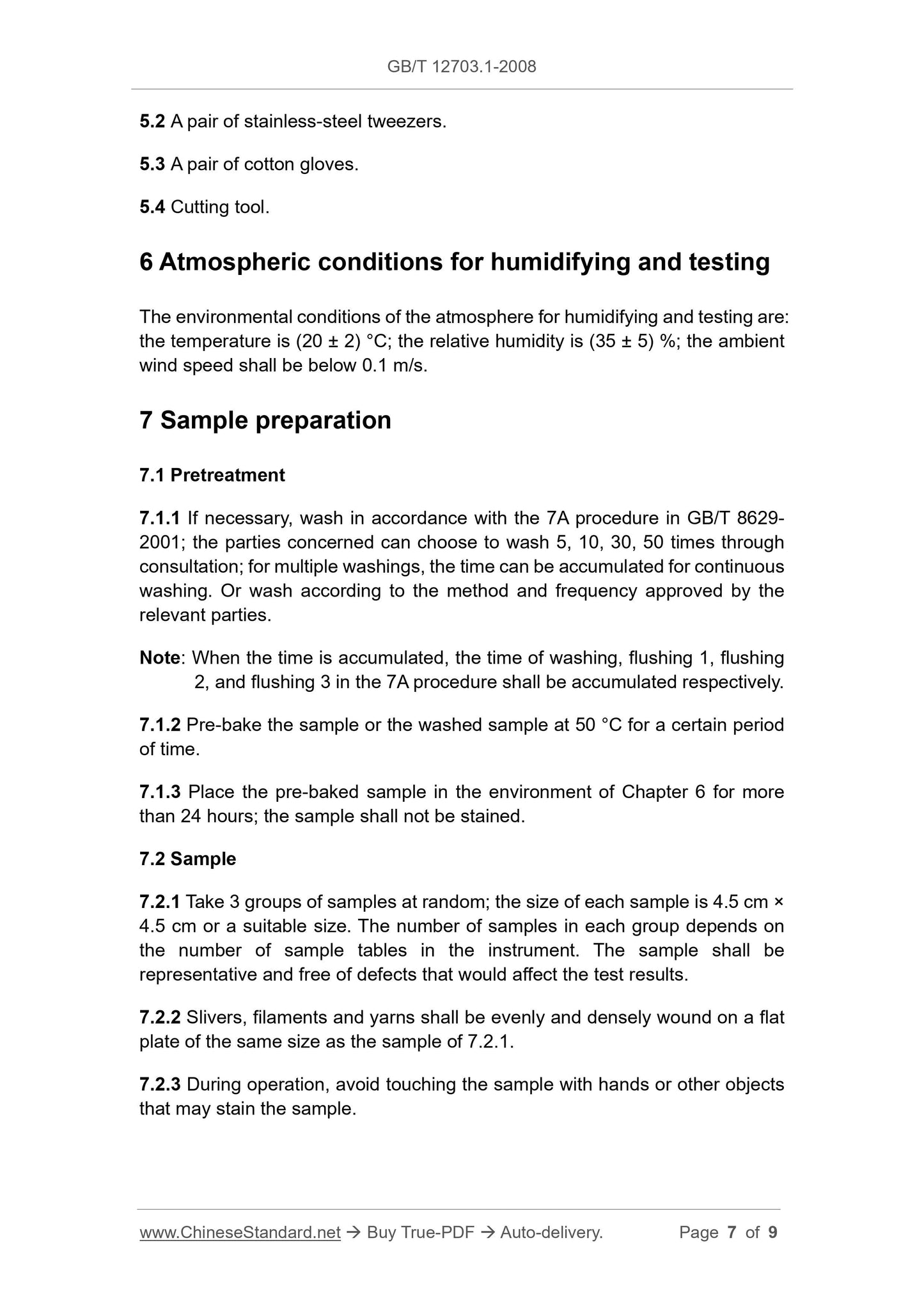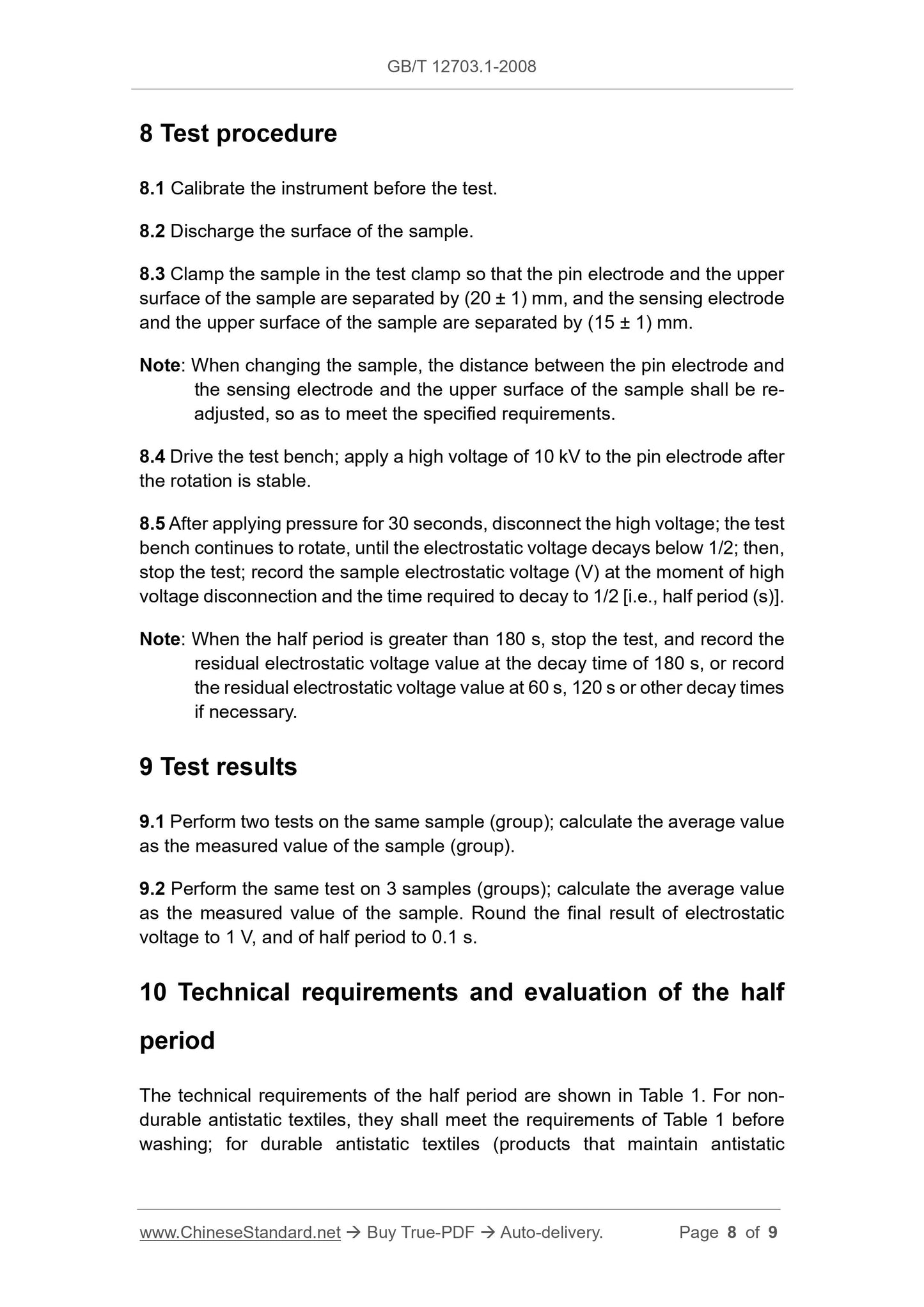1
/
of
5
PayPal, credit cards. Download editable-PDF and invoice in 1 second!
GB/T 12703.1-2008 English PDF (GB/T12703.1-2008)
GB/T 12703.1-2008 English PDF (GB/T12703.1-2008)
Regular price
$110.00 USD
Regular price
Sale price
$110.00 USD
Unit price
/
per
Shipping calculated at checkout.
Couldn't load pickup availability
Delivery: 3 seconds. Download true-PDF + Invoice.
Get QUOTATION in 1-minute: Click GB/T 12703.1-2008
Historical versions: GB/T 12703.1-2008
Preview True-PDF (Reload/Scroll if blank)
GB/T 12703.1-2008: Textile -- Evaluation for electrostatic properties -- Part 1: Static half period
GB/T 12703.1-2008
GB
NATIONAL STANDARD OF THE
PEOPLE’S REPUBLIC OF CHINA
ICS 59.080.01
W 04
Partly replacing GB/T 12703-1991
Textile - Evaluation for electrostatic properties -
Part 1: Static half period
ISSUED ON: JUNE 18, 2008
IMPLEMENTED ON: MARCH 01, 2009
Issued by: General Administration of Quality Supervision, Inspection and
Quarantine;
Standardization Administration of the People’s Republic of
China.
Table of Contents
Foreword ... 3
1 Scope ... 5
2 Normative references ... 5
3 Terms and definitions ... 5
4 Principle ... 6
5 Equipment and utensils ... 6
6 Atmospheric conditions for humidifying and testing ... 7
7 Sample preparation ... 7
8 Test procedure ... 8
9 Test results ... 8
10 Technical requirements and evaluation of the half period ... 8
11 Test report ... 9
Textile - Evaluation for electrostatic properties -
Part 1: Static half period
1 Scope
This Part of GB/T 12703 specifies the test methods and evaluation indexes for
static half period of textiles.
This Part applies to all types of textiles, but to floor fabrics.
2 Normative references
The terms in the following documents become the terms of this Part by
reference to this Part of GB/T 12703. For dated references, all subsequent
amendments (not including errata content) or revisions do not apply to this Part.
However, parties to agreements that are based on this Part are encouraged to
study whether the latest versions of these documents can be used. For undated
references, the latest edition applies to this Part.
GB/T 8629-2001, Textiles - Domestic washing and drying procedures for
textile testing
3 Terms and definitions
The following terms and definitions are applicable to this Part of GB/T 12703.
3.1
Electrostatic voltage
The potential to ground that is generated by the relatively stable charges which
are accumulated on the sample.
3.2
Static half period
The time that is required for the electrostatic voltage on the sample to decay to
half of the original value.
5.2 A pair of stainless-steel tweezers.
5.3 A pair of cotton gloves.
5.4 Cutting tool.
6 Atmospheric conditions for humidifying and testing
The environmental conditions of the atmosphere for humidifying and testing are:
the temperature is (20 ± 2) °C; the relative humidity is (35 ± 5) %; the ambient
wind speed shall be below 0.1 m/s.
7 Sample preparation
7.1 Pretreatment
7.1.1 If necessary, wash in accordance with the 7A procedure in GB/T 8629-
2001; the parties concerned can choose to wash 5, 10, 30, 50 times through
consultation; for multiple washings, the time can be accumulated for continuous
washing. Or wash according to the method and frequency approved by the
relevant parties.
Note: When the time is accumulated, the time of washing, flushing 1, flushing
2, and flushing 3 in the 7A procedure shall be accumulated respectively.
7.1.2 Pre-bake the sample or the washed sample at 50 °C for a certain period
of time.
7.1.3 Place the pre-baked sample in the environment of Chapter 6 for more
than 24 hours; the sample shall not be stained.
7.2 Sample
7.2.1 Take 3 groups of samples at random; the size of each sample is 4.5 cm ×
4.5 cm or a suitable size. The number of samples in each group depends on
the number of sample tables in the instrument. The sample shall be
representative and free of defects that would affect the test results.
7.2.2 Slivers, filaments and yarns shall be evenly and densely wound on a flat
plate of the same size as the sample of 7.2.1.
7.2.3 During operation, avoid touching the sample with hands or other objects
that may stain the sample.
8 Test procedure
8.1 Calibrate the instrument before the test.
8.2 Discharge the surface of the sample.
8.3 Clamp the sample in the test clamp so that the pin electrode and the upper
surface of the sample are separated by (20 ± 1) mm, and the sensing electrode
and the upper surface of the sample are separated by (15 ± 1) mm.
Note: When changing the sample, the distance between the pin electrode and
the sensing electrode and the upper surface of the sample shall be re-
adjusted, so as to meet the specified requirements.
8.4 Drive the test bench; apply a high voltage of 10 kV to the pin electrode after
the rotation is stable.
8.5 After applying pressure for 30 seconds, disconnect the high voltage; the test
bench continues to rotate, until the electrostatic voltage decays below 1/2; then,
stop the test; record the sample electrostatic voltage (V) at the moment of high
voltage disconnection and the time required to decay to 1/2 [i.e., half period (s)].
Note: When the half period is greater than 180 s, stop the test, and record the
residual electrostatic voltage value at the decay time of 180 s, or record
the residual electrostatic voltage value at 60 s, 120 s or other decay times
if necessary.
9 Test results
9.1 Perform two tests on the same sample (group); calculate the average value
as the measured value of the sample (group).
9.2 Perform the same test on 3 samples (groups); calculate the average value
as the measured value of the sample. Round the final result of electrostatic
voltage to 1 V, and of half period to 0.1 s.
10 Technical requirements and evaluation of the half
period
The technical requirements of the half period are shown in Table 1. For non-
durable antistatic textiles, they shall meet the requirements of Table 1 before
washing; for durable antistatic textiles (products that maintain antistatic
Get QUOTATION in 1-minute: Click GB/T 12703.1-2008
Historical versions: GB/T 12703.1-2008
Preview True-PDF (Reload/Scroll if blank)
GB/T 12703.1-2008: Textile -- Evaluation for electrostatic properties -- Part 1: Static half period
GB/T 12703.1-2008
GB
NATIONAL STANDARD OF THE
PEOPLE’S REPUBLIC OF CHINA
ICS 59.080.01
W 04
Partly replacing GB/T 12703-1991
Textile - Evaluation for electrostatic properties -
Part 1: Static half period
ISSUED ON: JUNE 18, 2008
IMPLEMENTED ON: MARCH 01, 2009
Issued by: General Administration of Quality Supervision, Inspection and
Quarantine;
Standardization Administration of the People’s Republic of
China.
Table of Contents
Foreword ... 3
1 Scope ... 5
2 Normative references ... 5
3 Terms and definitions ... 5
4 Principle ... 6
5 Equipment and utensils ... 6
6 Atmospheric conditions for humidifying and testing ... 7
7 Sample preparation ... 7
8 Test procedure ... 8
9 Test results ... 8
10 Technical requirements and evaluation of the half period ... 8
11 Test report ... 9
Textile - Evaluation for electrostatic properties -
Part 1: Static half period
1 Scope
This Part of GB/T 12703 specifies the test methods and evaluation indexes for
static half period of textiles.
This Part applies to all types of textiles, but to floor fabrics.
2 Normative references
The terms in the following documents become the terms of this Part by
reference to this Part of GB/T 12703. For dated references, all subsequent
amendments (not including errata content) or revisions do not apply to this Part.
However, parties to agreements that are based on this Part are encouraged to
study whether the latest versions of these documents can be used. For undated
references, the latest edition applies to this Part.
GB/T 8629-2001, Textiles - Domestic washing and drying procedures for
textile testing
3 Terms and definitions
The following terms and definitions are applicable to this Part of GB/T 12703.
3.1
Electrostatic voltage
The potential to ground that is generated by the relatively stable charges which
are accumulated on the sample.
3.2
Static half period
The time that is required for the electrostatic voltage on the sample to decay to
half of the original value.
5.2 A pair of stainless-steel tweezers.
5.3 A pair of cotton gloves.
5.4 Cutting tool.
6 Atmospheric conditions for humidifying and testing
The environmental conditions of the atmosphere for humidifying and testing are:
the temperature is (20 ± 2) °C; the relative humidity is (35 ± 5) %; the ambient
wind speed shall be below 0.1 m/s.
7 Sample preparation
7.1 Pretreatment
7.1.1 If necessary, wash in accordance with the 7A procedure in GB/T 8629-
2001; the parties concerned can choose to wash 5, 10, 30, 50 times through
consultation; for multiple washings, the time can be accumulated for continuous
washing. Or wash according to the method and frequency approved by the
relevant parties.
Note: When the time is accumulated, the time of washing, flushing 1, flushing
2, and flushing 3 in the 7A procedure shall be accumulated respectively.
7.1.2 Pre-bake the sample or the washed sample at 50 °C for a certain period
of time.
7.1.3 Place the pre-baked sample in the environment of Chapter 6 for more
than 24 hours; the sample shall not be stained.
7.2 Sample
7.2.1 Take 3 groups of samples at random; the size of each sample is 4.5 cm ×
4.5 cm or a suitable size. The number of samples in each group depends on
the number of sample tables in the instrument. The sample shall be
representative and free of defects that would affect the test results.
7.2.2 Slivers, filaments and yarns shall be evenly and densely wound on a flat
plate of the same size as the sample of 7.2.1.
7.2.3 During operation, avoid touching the sample with hands or other objects
that may stain the sample.
8 Test procedure
8.1 Calibrate the instrument before the test.
8.2 Discharge the surface of the sample.
8.3 Clamp the sample in the test clamp so that the pin electrode and the upper
surface of the sample are separated by (20 ± 1) mm, and the sensing electrode
and the upper surface of the sample are separated by (15 ± 1) mm.
Note: When changing the sample, the distance between the pin electrode and
the sensing electrode and the upper surface of the sample shall be re-
adjusted, so as to meet the specified requirements.
8.4 Drive the test bench; apply a high voltage of 10 kV to the pin electrode after
the rotation is stable.
8.5 After applying pressure for 30 seconds, disconnect the high voltage; the test
bench continues to rotate, until the electrostatic voltage decays below 1/2; then,
stop the test; record the sample electrostatic voltage (V) at the moment of high
voltage disconnection and the time required to decay to 1/2 [i.e., half period (s)].
Note: When the half period is greater than 180 s, stop the test, and record the
residual electrostatic voltage value at the decay time of 180 s, or record
the residual electrostatic voltage value at 60 s, 120 s or other decay times
if necessary.
9 Test results
9.1 Perform two tests on the same sample (group); calculate the average value
as the measured value of the sample (group).
9.2 Perform the same test on 3 samples (groups); calculate the average value
as the measured value of the sample. Round the final result of electrostatic
voltage to 1 V, and of half period to 0.1 s.
10 Technical requirements and evaluation of the half
period
The technical requirements of the half period are shown in Table 1. For non-
durable antistatic textiles, they shall meet the requirements of Table 1 before
washing; for durable antistatic textiles (products that maintain antistatic
Share
